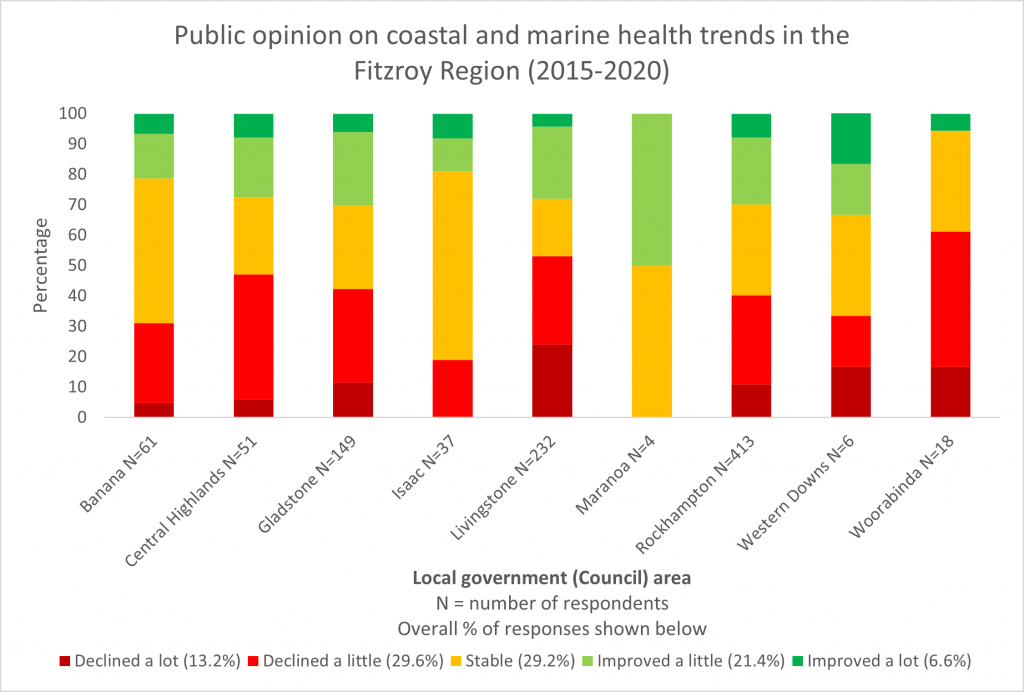Coastal and Marine Ecosystems
Our regional coastal and marine systems matter to more than just us; they provide economic, social, cultural and weather services here and around the globe.
Our front door opens onto the southern expanse of an international icon
Coastal and marine systems, and particularly the infamous Great Barrier Reef, are a key part of our regional and Australian identity. More than 85% of Australians live within 50 kilometres of the sea, and our nation relies on the coast for almost all our international trade. Notably, Gladstone is home to Queensland’s largest multi-commodity port and a key commercial fishing area for CQSS2030 region. Both commercial wild-catch fishing and tourism industries are important contributors to our regional and national economy (nationally, they are currently valued at approximately $50 billion per year, and expected to double over the next few years) and rely on healthy coastal and marine systems. Unsurprisingly, our coastal waters form an important basis for our regional recreation industry, with central Queensland residents reporting one of the state’s highest recreational fishing rates. 33.2% and 28.4% of us report fishing at least once a year in the Gladstone and Rockhampton areas, with most preferring to fish in coastal estuaries and inshore waters.
Importantly, coastal and marine systems are at the frontline of rising sea levels, storm surges and extreme weather and play a critical role in controlling global weather patterns. They also support incredible biodiversity, containing a variety of species that have important biological, social, and cultural values to people here and right around the globe. In addition, they are one of the keys to ensuring human health with fish being the fourth-highest category of protein consumed by Australians, and oceans providing up to 80% of the oxygen we breathe.

Marine and coastal health is measured by a wide variety of things including the amount of pollution (plastic, fishing gear, sediment and/or chemicals), fish productivity, species populations, habitat condition and extent, water temperature and acidity levels. Social, cultural and economic indicators are also important indicators of system health.
Diagram adapted from GHHP
Put another way, our regional marine and coastal areas:
- help support global, national, and local food security
- form and help protect part of the Great Barrier Reef
- are a valuable tourist destination in their own right
- underpin local economic growth, jobs and wellbeing
- protect locally and globally significant species
- buffer our coastal communities and industries against extreme storms and tidal surges
- help keep our local (and cumulatively global) temperatures cooler
- absorb carbon which helps reduce greenhouse gases and global warming
- help produce up to 80% of the air we breathe
DID YOU KNOW? The Great Barrier Reef accounts for more than 15% of the world’s tourism industry revenue (approximately US$5.7 billion each year). In 2015-16 alone, it was estimated to generate $3.9 billion and 33,000 jobs for Queensland.
Source
All drains lead to the ocean…and back to us
Our coastal and marine systems face many threats from a wide variety of sources and the results often interact in a way that intensifies the damage. These negative feedback loops also impact us, our weather, and land-based ecosystems.
Many of the threats are a combination of local and global human activities that stem from not knowing how much damage one action can create or being focused (understandably) on more immediate concerns like earning a living or securing food. A lack of understanding about the interconnections between land, water, weather and marine systems and their connection to our personal health, and food and economic systems is also part of the problem. Luckily, there is a lot we can do in our region to help safeguard our local coasts and marine areas.
The biggest threats to our region’s coastal and marine systems and the plants and animals they support include:
- Increases in the ocean and air temperatures (on average, these have both risen by 1degree Celsius over the last century)
- Regional land clearing for ports, industry, urban and agricultural areas (particularly in coastal areas, but clearing further inland also causes damage – see 3 below)
- Pollution from agricultural, urban and industrial runoff. This includes soil and the nutrients and chemicals carried with it, as well as plastics and non-biodegradable rubbish of all types and sizes
- Changes to water flow from and between freshwater, coastal and groundwater systems.
- Rising sea levels and more frequent and severe weather events
- Overharvesting of coastal, and more often marine plants and animals both locally and further afield
- Damage caused by recreational and commercial boating and diving activities.
DID YOU KNOW? A 2019 study revealed that, on average, we consume the equvalent of a credit card in plastic each week (5g), or a dinner plate each year (250g). Most of this comes through seafood that has eaten microplastics from the cosmetics and non-natural clothes fibres that wash into the ocean.
Source
Discover the biggest threats to our natural assets
 We need to turn the tide on more than just global emissions
We need to turn the tide on more than just global emissions
Because coastal and marine systems are at the end of the line (subject to everything that washes down our rivers and streams), and subject to global ocean currents and weather patterns, they face multiple interacting pressures and increased negative impacts. Extreme weather events in recent years have resulted in widespread coral bleaching, habitat loss and species mortality in our region.
Whilst some pressures are decreasing due to stricter regulations on Australian commercial fisheries, development, agricultural industries, and the oil and gas industry, other pressures are continuing to increase with insufficient data available on their impacts. Although stricter regulations are in place for commercial fisheries, compliance is not well documented, and recreational fishing takes are not easily or routinely monitored. Bycatch from commercial and recreational fishing is also not well known or addressed. The level of vessel activity in marine waters and estuaries continues to grow, and along with it, the associated risks of vessel strike, boat groundings, damage to critical areas, and foreign species.
The combined impact of these multiple pressures will only worsen as our regional and coastal populations grow, sea levels and temperatures continue to rise and weather patterns change.
DID YOU KNOW? On our current trajectory, global temperatures are set to rise 1.5-2 degrees Celsius this century (another 0.5-1 degree Celsius). If we find ways to avoid this, we could save 70-99% of remaining coral reefs around the world, and in Australia more than 64,000 reef related jobs and $6+ billion in income.
Source
In 2020, we asked our community how they thought the health of coastal and marine environments in the region were trending based on the preceding five years. The majority of respondents reported this asset to be stable to declining.

Asset status is a ready estimator based on:
- Global, Australian and Queensland reports
- The likely impact on our businesses, communities, economy and future if we change nothing in the next five years
- Results of the 2020 regional natural assets community survey
![]()
Urgent action is needed! Trends indicate things are in a bad way. We need to act now!
Asset status is a ready estimator based on:
- Global, Australian and Queensland reports
- The likely impact on our businesses, communities, economy and future if we change nothing in the next five years
- Results of the 2020 regional natural assets community survey
Our region is not at a point where available data can be collated and analysed using a scientifically validated model to produce an accurate report on the status of our region’s six region’s natural assets and two key drivers.



